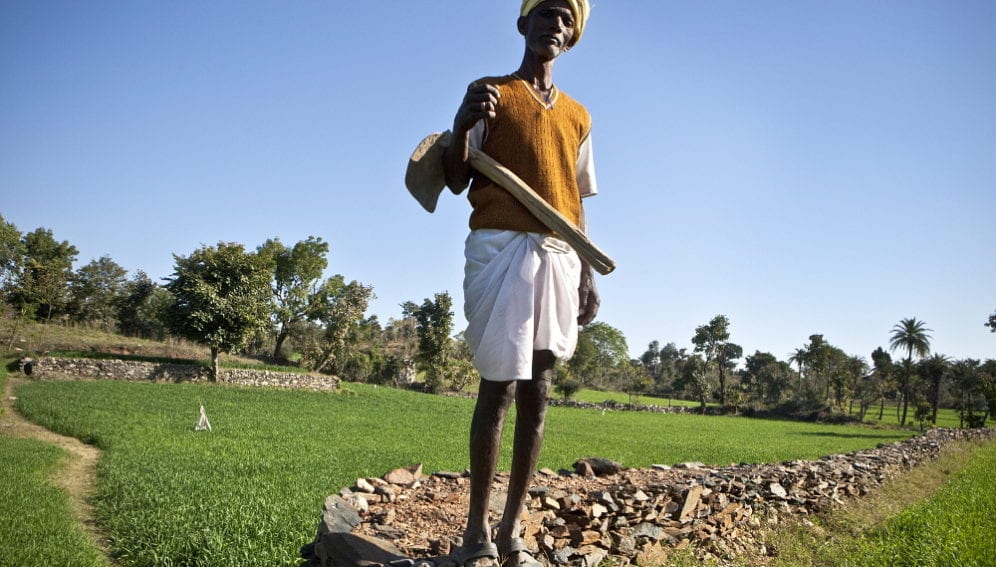By: Ranjit Devraj
Send to a friend
The details you provide on this page will not be used to send unsolicited email, and will not be sold to a 3rd party. See privacy policy.
Public opposition to GM trials is fuelling government indecision, stranding India’s food research in the lab.
In August, India’s ruling nationalist Bharatiya Janata Party (BJP) stopped its legislators from accepting Monsanto sponsorship to attend a farm exhibition in the US state of Iowa. On the surface this might seem strange: attending the Farm Progress Show should be innocuous, as Monsanto routinely takes farmers, industry experts, media and MPs from various countries to visit the show and experience for themselves the advances in agriculture.
But clearly the BJP government wants to avoid any accusations of undue influence when deciding whether India, a largely farming country of 1.2 billion people, is going to grow GM food crops commercially.
This was one of several signs of the government’s caution around genetically modified (GM) crops. Yet the government must be careful that its caution does not translate into a freezing of Indian scientists’ research into the crops.
GM cotton not a grand success
While India has been cultivating Monsanto’s ‘Bt cotton’ since 2002, farmers and environmental activists have fiercely resisted GM food crops. This may in part be because India’s experience with GM cotton has not exactly been a runaway success. In theory, Bt cotton should cut pesticide use by making the plant produce a chemical toxic to bollworm pests, the genes for which come originally from the soil bacterium Bacillus thuringiensis. The problem is that the technology mostly benefits the biotech seed industry rather India’s cotton farmers. This is in part because Bt cotton needs a regular flow of water to flourish, whereas most Indian farmers rely on rains to water their crops. Problems such as this and the cost of patented seeds may have driven hundreds of small-scale farmers to penury and even suicide.
It has to be said that the Bt gene technology did raise India’s cotton yields from 190 to 512 kilograms per hectare between 2001 and 2011. But Keshav Kranthi, director of India’s Central Institute for Cotton Research, says continued pesticide use and non-GM inputs contributed to the high yields. And now there’s an additional complication: other pests that are not susceptible to the Bt toxin are showing up, so yields are likely to fall again. It seems that the best that can be said about Monsanto’s GM cotton is that it helped Indian farmers begin to engage with modern agricultural biotechnology.
Food crop furore
GM food crops are even more controversial. For one thing, consumers are yet to be reassured about safety. Some fear that any possible health impacts caused by GM food may not show up for several generations — and given the timescales involved it is hard for scientists to allay these fears.
“Facing powerful lobbying and indecisive safety evidence, the government’s hands are tied on GM.”
Ranjit Devraj
Then there are the voices hostile to GM outside the country. Europe’s stiff resistance, for example, has not been lost on Indian farmers, consumers and activists. And certainly not on Jairam Ramesh, India’s former environment minister. In February 2010, Ramesh ordered a moratorium on field trials of GM aubergine that uses Monsanto’s Bt gene technology after nation-wide consultations revealed their unpopularity. Large states like Rajasthan and Bihar also ordered field trials of GM crops like mustard and maize to be set on fire, while others have declared themselves to be “GM-free”.
Responsibility for agriculture lies at the state level in India, so corporations hoping to promote GM crops must ultimately deal with local government. But until Ramesh’s public consultations, the dialogue over GM was largely confined to the central government’s science bureaucracy and the big agro-corporations, dogged by activists.
Genetic contamination
Among other issues, activists argued that the biosafety aspects of splicing Bt genes into aubergine were glossed over. For example, plant scientists have been warning that Bt genes could spread through natural cross-pollination and contaminate dozens of native aubergine varieties. Ramesh appeared to take these concerns on board, and when ordering the moratorium he said independent, long-term scientific studies were warranted.
The moratorium found support in a technical experts’ committee mandated to advise India’s Supreme Court on a public interest litigation against GM crops. In 2013, the committee recommended an indefinite moratorium on further field trials of all GM crops (not just Bt varieties) until competent regulatory and safety mechanisms were in place. It also recommended a blanket ban on growing commercial GM varieties of crops — such as rice and mustard — that originated in India, or that have their greatest diversity there. The aim was to avoid genetic contamination with its unknown consequences for biodiversity.
Flip-flop decisions
Soon after the May 2014 elections, the pro-business BJP government tried to overturn Ramesh’s moratorium by announcing field trials for several crops, including GM aubergine. But within weeks, pressure from groups affiliated to the party, rather than from activists, pushed the government to suspend the trials and to stop legislators from accepting Monsanto’s Iowa invitation.
The government’s continued flip-flopping over field trials has disappointed Indian research scientists. Delhi University has spent 18 painstaking years developing high-yielding GM mustard only to run into bans on field trials. Its developer, Deepak Pental, says that trials with good biosafety protocols are safe and should be allowed, although he concedes that GM mustard could naturally cross with non-GM varieties, once released commercially.
So will the Indian government grasp the GM nettle? Asked this question at a public meeting in August, environment minister Prakash Javdekar remained cautious — and cryptic — saying: “We are not saying no to science. We have to take proper caution. We have to take proper action.”
Such non-committal statements confirm a sad fact. Facing powerful lobbying and indecisive safety evidence, the government’s hands are tied on GM. Until it can undo the knot, India’s scientists dedicated to finding GM solutions to the nation’s food insecurity will be wasting their time.
Ranjit Devraj is the regional co-ordinator for SciDev.Net’s South Asia edition.














